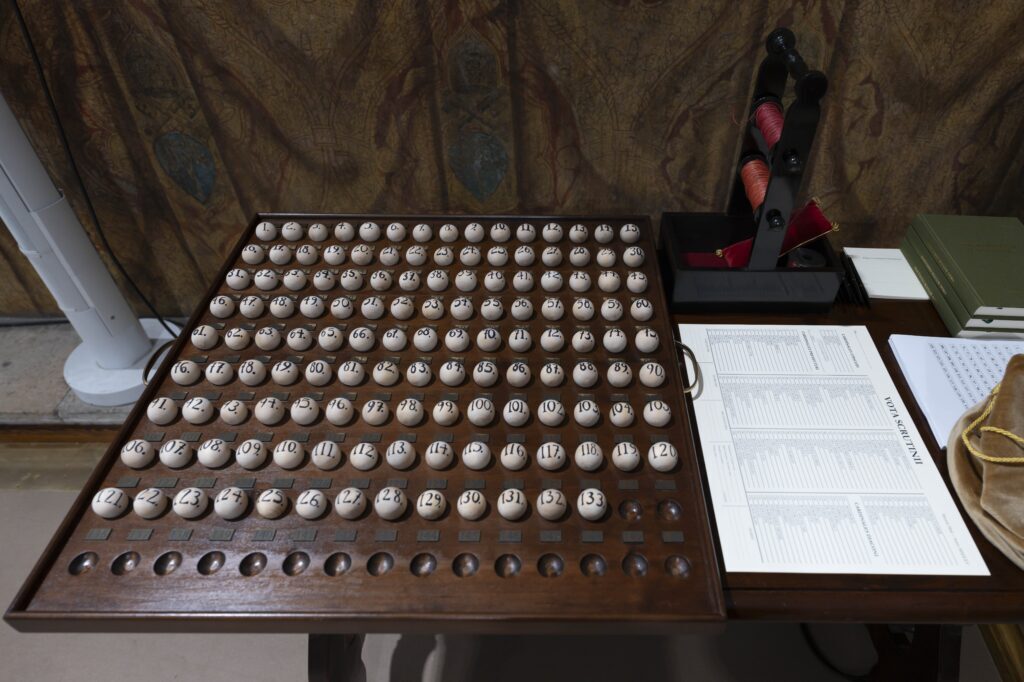VATICAN CITY (CNS) – On the eve of the conclave that will decide the next pontiff, the ring and lead seal of the late Pope Francis were destroyed.
In a video released by the Vatican May 6, an unidentified woman scratched a cross on the papal ring, known as the fisherman’s ring, as well as on a lead seal bearing the papal insignia used to mark Pope Francis’ letters.
When asked why the destruction of the ring and the seal took place at the meeting and not immediately after the pope’s death, Matteo Bruni, director of the Vatican press office, told journalists that the rules in the apostolic constitution, “Universi Dominici Gregis,” which governs the interregnum and election of a new pope, does not specify a precise time.
According to the apostolic constitution, the cardinals “arrange for the destruction of the fisherman’s ring and of the lead seal with which Apostolic Letters are dispatched” when meeting at the general congregations.
Final general congregation meeting
At their final congregation meeting, Bruni said, the cardinals discussed several issues, including the continuation of reforms initiated by Pope Francis, the fight against clergy sexual abuse and the care for creation.
The cardinals also emphasized the characteristics of the next pope, highlighting the importance “of communion” which was viewed “as an essential vocation for the new pontiff,” Bruni said.
“The profile of a shepherd pope, a teacher of humanity, capable of embodying the face of a Samaritan church, close to the needs and wounds of humanity, was outlined” at the last meeting, the Vatican reported in a communique. “In times marked by wars, violence and strong polarization, a strong need is felt for a spiritual guide who offers mercy, synodality and hope.”
Official calls for peace
The cardinals also approved an official declaration calling for peace in conflicts around the world, including in Ukraine and the Middle East. They lamented that “attacks, especially against civilian populations, have intensified.”
“We issue a heartfelt appeal to all parties involved to reach a permanent cease-fire as soon as possible and to negotiate, without preconditions or further delay, the peace long desired by the affected populations and the entire world,” the statement read.
At the press briefing, Bruni said the letter was the result of a proposal made at the general congregations and approved by the cardinals.

Questions addressed
Bruni was also asked about reports in which Kenyan Cardinal Njue, the retired archbishop of Nairobi, claimed to have not been invited to participate in the conclave.
The Vatican press office had said May 2 that Cardinal Njue and Spanish Cardinal Antonio Cañizares Llovera, the retired archbishop of Valencia, would not participate in the conclave due to health issues.
However, in an interview published May 6 by the Kenyan newspaper, The Nation, Cardinal Njue said he was not absent due to ill health but rather that he was never sent a formal invitation.
“Those who go there for the election are usually sent official invites and that has not happened on my part. I have not received an invitation,” the Kenyan cardinal said.
Shortly after, Archbishop Philip Anyolo of Nairobi issued a statement saying that Cardinal Njue had been “officially invited through the Apostolic Nunciature in Kenya.” The archbishop’s office had duly communicated to the Vatican that, “owing to his current health condition, (Cardinal Njue) will be unable to travel to Rome and take part in the conclave,” Archbishop Anyolo wrote.
The statement, however, did not clarify if Cardinal Njue was informed of the invitation. Bruni confirmed to journalists that the Vatican was told by the Nairobi archdiocese that Cardinal Njue would not participate due to health reasons and had no comment regarding the cardinal’s allegation.





